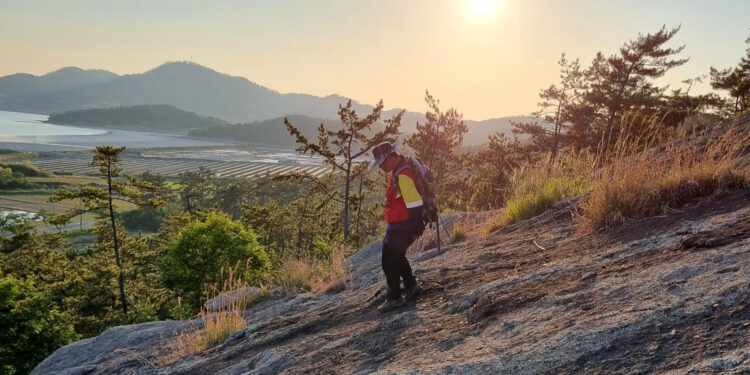Southern Gold Limited (ASX: SAU) has made licence applications over five areas prospective for lithium mineralization in South Korea.
Background
In 2022, Southern Gold commissioned RSC to undertake a desktop prospectivity study for REE and Li deposits in South Korea to complement its precious metals exploration portfolio. From this study, SAU lodged exploration applications over two REE projects last month. Several regional Li targets were also identified by RSC from anomalies defined in an historical country-wide stream-sediment sample survey conducted by the KIGAM.
After further targeting work of high-priority Li areas, together with preliminary reconnaissance fieldwork conducted by SAU and RSC during Q2-Q3 FY22, SAU has submitted new exploration licence applications over five prospective project areas.
Samguen Li Project
The Samguen Li Project includes five exploration licence applications covering 13.7km2, in the northern region of Gyeongsangbuk-do. Geology comprises Precambrian metasediment and gneiss intruded by pegmatites, aplites and felsic dykes. This project area contains anomalous Li from the KIGAM stream- sediment sampling survey with the highest value between 121 and 361ppm Li.
The project lies ~two km northwest of the historical Boam mine, where Li was mined from 1945–1963. The Uljin pegmatites consists of breccia-type and vein-type Li and tin (Sn) mineralisation, hosted within the Yulri Formation and Janggun Limestone.
The Uljin pegmatites contain spodumene and lepidolite as the major Li minerals and cassiterite as the primary Sn mineral.
Ridge-and-spur soil sampling was conducted by Peninsula Mines Limited in 2017 over ground that now includes the southern part of the Samguen project application area. This soil program was conducted following the return of anomalous stream-sediment sampling in the area by Peninsula. Values in soil samples up to 410ppm Li were returned within the SAU application licence area.
Seobyeok Li Project
The Seobyeok Li Project comprises of 36 exploration licence applications covering 98.8 km2, in northern Gyeongsangbuk-do. The application area comprises Precambrian schists, gneiss, and limestone, with pegmatites mapped by KIGAM located throughout the SAU exploration licence applications. Stream- sediment sampling from the historical KIGAM survey returned high values between 163 and 409ppm Li. The project is ~10km northeast of mapped Jurassic granite, which could be a potential source granite for the Li pegmatites.
Cheongsong Li Project
The Cheongsong Li Project comprises 34 exploration licence applications that cover 94.4km2, in the southern region of Gyeongsangbuk-do. The application area comprises Cretaceous and Jurassic granite and Cretaceous volcanics and sedimentary rocks. Stream-sediment sampling from the historical KIGAM survey returned values between 121 and 361ppm Li . This project area lies about seven to 9km south to southwest of mapped Jurassic granite, which may be the potential source for Li pegmatites.
Yeongdong Li Project
The Yeongdong Li Project comprises 26 exploration licence applications that cover 72.2km2, in the southern region of Chungcheongbuk-do. The application area is situated on the crustal-scale, NNE-trending, Gwangju strike-slip fault. The NW region of the Gwangju Fault is dominated by Cretaceous and Jurassic granite while the SW region is dominated by Precambrian gneiss. The NW region of the project area returned highest Li value between 178 and 574ppm from historical stream-sediment sampling by KIGAM.
Buyeo Li Project
The Buyeo Li Project comprises 63 exploration licence applications cover 174.8sq. km, in the southern region of Chungcheongnam-do. The geology of the application area is dominated by Jurassic Daebo granite and Precambrian gneiss and schist. Large-scale ENE-trending faults separate two plutons of Daebo granite, creating a potential structural pathway for the migration of melts and/or hydrothermal fluids. Elevated Li concentrations in the KIGAM stream-sediment survey occur in the western part of the application area.
Li Demand in South Korea
In February this year, the Ministry of Trade, Industry and Energy released a new strategy to secure a stable supply of critical minerals, listing Li among the top 10 given that South Korea is heavily reliant on mineral imports to support its battery, electric vehicle and clean technology sectors. The strategy outlines new incentives to encourage participation by private companies in exploration and mining, including in research and development projects.
The South Korean government and its top battery companies plan to jointly invest US$15.1B through 2023 to develop advanced battery technologies, including solid state batteries, including Posco Holdings who are investing US$353M in a new Li-hydroxide plant in the southern industrial city of Gwangyang.10 Accordingly, any Li discovery made by SAU could have the positive benefit of close proximity to Li processing and battery manufacturing plants and highly developed national transport infrastructure.
Next Steps
Fieldwork is now underway and will comprise regional stream-sediment sampling, rock-chip sampling, and geological mapping to focus for subsequent detailed exploration and target development. First geochemical results from this regional exploration programme are planned to be returned in Q4 FY23 – Q1 FY24, depending on progress and lab turn-around times. Further review and translation of key KIGAM and KETEP reports on the Boam Li deposit will also continue to assist to guide the wider exploration programme.
The team are in the field this week with a third party who is assessing their interest in the lithium potential of Southern Gold’s applications. Management is greatly encouraged by the interest of this third party in the Lithium potential of South Korea and believes it provides early validation of the Board’s decision to expand its scope beyond primarily looking for potential gold deposits.
SAU will also continue to investigate the potential for other styles of Li deposits in South Korea as part of wider on-going generative studies, including HARSH (hydrothermally altered rhyolitic sediment-hosted) Li deposits.
For further information please visit: http://southerngold.com.au/












